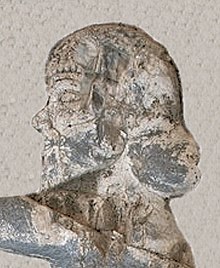
Back بارديا Arabic بارديا ARZ بردیا AZB Бардыя Byelorussian Бардыя BE-X-OLD Smerdis de Pèrsia Catalan Smerdis Czech Smerdis, brenin Persia Welsh Bardiya German Σμέρδις της Περσίας Greek
| Bardiya 𐎲𐎼𐎮𐎡𐎹 | |
|---|---|
 Portrait of the Achaemenid ruler toppled by Darius, as appearing on the Behistun inscription: he was either the legitimate Bardiya, or, as claimed by Darius, an imposter named Gaumāta. | |
| King of Kings of the Achaemenid Empire, Pharaoh of Egypt | |
| Reign | 522 BC |
| Predecessor | Cambyses II |
| Successor | Darius the Great |
| Burial | 522 BC |
| Spouse | Phaedymia |
| Issue | Parmys |
| Dynasty | Achaemenid |
| Father | Cyrus the Great |
| Mother | Cassandane |
| Religion | Zoroastrianism |
Bardiya or Smerdis (Old Persian: 𐎲𐎼𐎮𐎡𐎹[1] Bardiya;[2] Ancient Greek: Σμέρδις Smérdis;[3] possibly died 522 BCE), also named as Tanyoxarces (Old Persian: *Tanūvazraka; Ancient Greek: Τανυοξάρκης Tanuoxárkēs) by Ctesias, was a son of Cyrus the Great and the younger brother of Cambyses II, both Persian kings. There are sharply divided views on his life. Bardiya either ruled the Achaemenid Empire for a few months in 522 BCE, or was impersonated by a magus called Gaumata (Old Persian: 𐎥𐎢𐎶𐎠𐎫 Gaumāta), whose name is given by Ctesias as Sphendadates (Old Persian: *Spantadātah; Ancient Greek: Σφενδαδάτης Sphendadátēs), until he was toppled by Darius the Great.[4][2]
- ^ Akbarzadeh, D.; A. Yahyanezhad (2006). The Behistun Inscriptions (Old Persian Texts) (in Persian). Khaneye-Farhikhtagan-e Honarhaye Sonati. p. 59. ISBN 964-8499-05-5.
- ^ a b Kent, Roland G. (1950). Old Persian: Grammar, Texts, Lexicon.
- ^ "Bardiya | king of Persia". Encyclopedia Britannica. Retrieved 2020-08-14.
- ^ Akbarzadeh, D.; A. Yahyanezhad (2006). The Behistun Inscriptions (Old Persian Texts) (in Persian). Khaneye-Farhikhtagan-e Honarhaye Sonati. p. 60. ISBN 964-8499-05-5.
© MMXXIII Rich X Search. We shall prevail. All rights reserved. Rich X Search